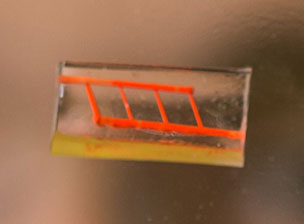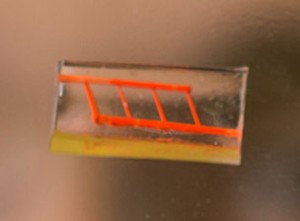Researchers to Print Blood Vessels

Latest News
November 20, 2015
A key barrier to “growing” very large artificial organs like livers or kidneys has been the challenge of delivering oxygen throughout the organ while it is still developing in the lab. While tissue engineers can use tissue scaffolds to try to link the new organ to nearby blood vessels, it can take weeks for those vessels to develop. In a large organ, interior cells can die off during that process.
 Red dye shows the tiny vessels in the silicone construct printed at Rice University. Image Courtesy Jeff Fitlow/Rice University.
Red dye shows the tiny vessels in the silicone construct printed at Rice University. Image Courtesy Jeff Fitlow/Rice University.Researchers at Rice University and the University of Pennsylvania may have come up with a solution — an implant that includes a network of blood vessels, created using a 3D printer.
The research was published in Tissue Engineering Part C: Methods earlier this year.
Using a technique inspired by the sugar glass cages pastry chefs use to decorate cakes, the team crafted a lattice of potential blood vessels with filaments of sugar glass and an open-source 3D printer. The hardened sugar is placed in a mold and covered with silicone gel. The sugar is then dissolved, creating tiny channels in the silicone.
“They don’t yet look like the blood vessels found in organs, but they have some of the key features relevant for a transplant surgeon,” said Jordan Miller, assistant professor of bioengineering at Rice, and leader of the research team. “We created a construct that has one inlet and one outlet, which are about 1 millimeter in diameter, and these main vessels branch into multiple smaller vessels, which are about 600 to 800 microns.”
Surgeons at the University of Pennsylvania connected the inlet and outlet in the structure to an artery in a small animal model. It remained open for blood flow for up to three hours.
“This study provides a first step toward developing a transplant model for tissue engineering where the surgeon can directly connect arteries to an engineered tissue,” Miller said. “In the future we aim to utilize a biodegradable material that also contains live cells next to these perfusable vessels for direct transplantation and monitoring long term.”
Source: Futurity
Subscribe to our FREE magazine, FREE email newsletters or both!
Latest News
About the Author
Brian Albright is the editorial director of Digital Engineering. Contact him at [email protected].
Follow DE





